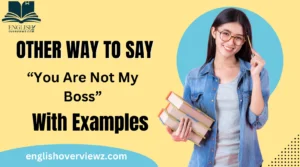Sometimes, it’s the little things that make our messages feel warm and thoughtful. Like when someone wishes you a good day or compliments you, and you want to send that kindness right back—but saying “You as well” every time feels a little… predictable.
Don’t worry! In this guide, we’ll explore 20 friendlier, warmer, and more creative ways to say it. Whether you’re writing an email, texting a friend, or talking to someone special, these options will make you sound natural and caring.
What Does “You As Well” Mean?
“You as well” is like passing the good vibes back to someone. When someone wishes you something nice, you simply return the favor. It’s short, polite, and shows you’re being thoughtful. For example, if someone says, “Have a great weekend!”, you’d reply, “You as well!” It’s like saying, “I hope the same for you!”
It’s a friendly way to mirror the kindness you just received. Simple, right?
Is It Professional/Polite to Say “You As Well”?
Yes! “You as well” is both polite and professional, which makes it super versatile. You can use it in emails, meetings, or even with friends. It fits almost anywhere because it’s respectful without sounding stiff.
However, using some alternatives can make you sound even warmer and a bit more human, especially in personal chats or friendly work emails. We’ll explore those soon!
Pros and Cons of Saying “You As Well”

Pros:
- Short and easy to use
- Works in both casual and formal settings
- Shows thoughtfulness
Cons:
- Can feel a bit plain or overused
- Lacks personal touch in warm conversations
- Sometimes feels automatic rather than heartfelt
Synonyms for “You As Well”
- Same to You!
- Right Back at You!
- You Too!
- Wishing You the Same!
- Likewise!
- Sending Good Vibes Your Way!
- Hope You Enjoy Too!
- Cheers to That!
- Much Appreciated, and to You as Well!
- Back at You!
- Same Goes for You!
- I Hope So for You Too!
- Wishing That for You Too!
- Hoping the Same for You!
- Reflecting Those Wishes Back!
- Ditto!
- Glad You Said That, Same Here!
- Appreciate That, Hope the Same for You!
- Thanks! Hope You Enjoy as Well!
- Same Happiness to You!
1. Same to You!
Here’s a cheerful way to bounce the good wishes back. “Same to you!” feels lively and upbeat.
It’s great because it keeps things casual but still polite. You’re matching their energy and keeping the conversation light.
Scenario Example:
Email:
“Thanks for the quick update! Have a great rest of your day.”
Reply:
“Thanks! Same to you!”
Best Use:
When you want to sound cheerful and casual.
Additional Note:
Perfect for both work chats and friendly emails. Adds a little bounce!
2. Right Back at You!
A playful option that feels like you’re tossing the kindness right back.
This one is a bit cheeky and fun, so it’s best when you know the person well enough to use a slightly playful tone.
Scenario Example:
Email:
“Enjoy your weekend getaway!”
Reply:
“Right back at you!”
Best Use:
When you’re in a friendly, casual conversation.
Additional Note:
Avoid this in very formal settings. Great with colleagues you’re familiar with!
3. You Too!
Simple, friendly, and universally loved. “You too!” is like the cousin of “You as well.”
It’s quick, natural, and never awkward. Plus, it fits in almost any situation.
Scenario Example:
Email:
“Have a productive afternoon!”
Reply:
“You too!”
Best Use:
When you want to keep it natural and easygoing.
Additional Note:
Works in casual and professional emails alike.
4. Wishing You the Same!
A slightly warmer, more thoughtful twist.
This sounds a bit more deliberate, like you truly mean it, not just replying automatically.
Scenario Example:
Email:
“Hope you have a fantastic trip!”
Reply:
“Wishing you the same!”
Best Use:
When you want your reply to feel a little extra sincere.
Additional Note:
Great for more heartfelt messages.
5. Likewise!
Short, smart, and neat. “Likewise!” is like the cool, confident reply.
It’s simple but carries a touch of class, making it great for professional settings.
Scenario Example:
Email:
“Pleasure meeting you today!”
Reply:
“Likewise!”
Best Use:
Perfect for formal and semi-formal conversations.
Additional Note:
Avoid overusing it—it can sound a bit too sharp if used too much.
6. Sending Good Vibes Your Way!
Now we’re getting warmer! This one feels fun and full of positivity.
It’s great when you want to keep the tone light and energetic.
Scenario Example:
Email:
“Hope your project launch goes smoothly!”
Reply:
“Sending good vibes your way!”
Best Use:
When you want to add extra positivity.
Additional Note:
Wonderful for creative teams or close colleagues.
7. Hope You Enjoy Too!
A friendly, open-hearted reply that feels genuine.
This one adds a nice personal touch, showing that you’re really paying attention.
Scenario Example:
Email:
“Have a great time at the conference!”
Reply:
“Hope you enjoy too!”
Best Use:
When replying to personal well-wishes.
Additional Note:
Suits warm, slightly informal emails.
8. Cheers to That!
A little celebratory! This reply feels like raising a toast to good wishes.
It works beautifully in friendly conversations, especially when you’re both celebrating something.
Scenario Example:
Email:
“Here’s to a successful campaign!”
Reply:
“Cheers to that!”
Best Use:
When you’re joining in their excitement.
Additional Note:
Skip this in very formal situations.
9. Much Appreciated, and to You as Well!
A combo move! You’re saying thanks and returning the wish at once.
It’s thoughtful and sounds very genuine, perfect for polite conversations.
Scenario Example:
Email:
“Have a restful weekend ahead!”
Reply:
“Much appreciated, and to you as well!”
Best Use:
When you want to sound extra courteous.
Additional Note:
Works in both formal and semi-formal settings.
10. Back at You!
Quick and playful, like tossing the compliment right back.
This is friendly and informal, so save it for people you’re comfortable with.
Scenario Example:
Email:
“Enjoy your Friday night!”
Reply:
“Back at you!”
Best Use:
Casual chats or light-hearted work exchanges.
Additional Note:
Steer clear in very professional emails.
11. Same Goes for You!
Natural, easygoing, and friendly.
This sounds like you’re having a real conversation, not just typing a reply.
Scenario Example:
Email:
“Hope your meeting goes well!”
Reply:
“Same goes for you!”
Best Use:
When you want to sound warm and conversational.
Additional Note:
Great for friendly and slightly casual messages.
12. I Hope So for You Too!
A gentle and caring option that feels genuine.
This shows you’re really thinking about their well-being, not just replying quickly.
Scenario Example:
Email:
“Hope you have a smooth presentation!”
Reply:
“I hope so for you too!”
Best Use:
When you want to express genuine care.
Additional Note:
Adds warmth to personal or thoughtful emails.
13. Wishing That for You Too!
Here’s a kind-hearted choice that feels personal.
It’s a wonderful way to mirror someone’s kindness with a little extra heart.
Scenario Example:
Email:
“Wishing you a joyful week!”
Reply:
“Wishing that for you too!”
Best Use:
Personal or friendly exchanges.
Additional Note:
Makes your message feel thoughtful and warm.
14. Hoping the Same for You!
This one feels deliberate, like you’ve paused to really wish them well.
It’s a subtle way to sound a bit more caring in your reply.
Scenario Example:
Email:
“Have a productive day!”
Reply:
“Hoping the same for you!”
Best Use:
When you want to sound kind and attentive.
Additional Note:
Ideal for personal messages or thoughtful emails.
15. Reflecting Those Wishes Back!
A creative, slightly poetic reply!
It’s like saying you’re bouncing their good thoughts right back to them.
Scenario Example:
Email:
“Wishing you a stress-free day!”
Reply:
“Reflecting those wishes back!”
Best Use:
When you want to be a bit playful and original.
Additional Note:
Better for casual or creative chats.
16. Ditto!
Short and snappy! “Ditto!” is fun, but use it with the right audience.
It feels a bit playful and relaxed, not super formal.
Scenario Example:
Email:
“Enjoy your day off!”
Reply:
“Ditto!”
Best Use:
Casual conversations with people you know well.
Additional Note:
Avoid in formal emails—it’s a bit too casual.
17. Glad You Said That, Same Here!
A mix of cheerfulness and sincerity.
It’s like saying, “I’m happy you wished that, and I wish it for you too!”
Scenario Example:
Email:
“Hope your plans go perfectly!”
Reply:
“Glad you said that, same here!”
Best Use:
Friendly emails with a dash of excitement.
Additional Note:
Adds personality and charm.
18. Appreciate That, Hope the Same for You!
You’re showing gratitude and sending kind thoughts back.
This feels warm and genuinely appreciative, great for heartfelt replies.
Scenario Example:
Email:
“Have a smooth and successful day!”
Reply:
“Appreciate that, hope the same for you!”
Best Use:
Professional yet warm conversations.
Additional Note:
Ideal balance of polite and friendly.
19. Thanks! Hope You Enjoy as Well!
A friendly and polite mix, keeps things natural.
It’s great because you’re saying thanks and returning the good vibes at once.
Scenario Example:
Email:
“Enjoy the team outing tomorrow!”
Reply:
“Thanks! Hope you enjoy as well!”
Best Use:
Everyday emails and friendly work chats.
Additional Note:
Casual yet polite—fits many situations.
20. Same Happiness to You!
Let’s finish with a warm and joyful phrase!
This reply spreads cheer and feels genuinely uplifting.
Scenario Example:
Email:
“Wishing you lots of happiness!”
Reply:
“Same happiness to you!”
Best Use:
When you want to sound extra cheerful and kind.
Additional Note:
Lovely for personal messages and festive occasions.
Conclusion
There you have it! 20 lively, warm, and thoughtful other ways to say “You as well” without sounding boring or robotic. Whether you’re texting a friend, replying to a colleague, or writing a heartfelt email, these alternatives will help you express care in a way that feels natural and genuine.
Remember: Little changes in words make a big difference in connection. Try these out, and you’ll notice how your conversations feel more personal and friendly!















